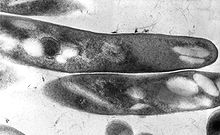
Back متفطرة Arabic متفطره ARZ Micobacteris Catalan Mycobacterium Czech Mykobakterien German Mycobacterium Spanish Mükobakter Estonian Mycobacterium Basque مایکوباکتریوم Persian Mykobakteerit Finnish
| Mycobacterium | |
|---|---|

| |
| TEM micrograph of M. tuberculosis | |
| Scientific classification | |
| Domain: | Bacteria |
| Phylum: | Actinomycetota |
| Class: | Actinomycetia |
| Order: | Mycobacteriales |
| Family: | Mycobacteriaceae |
| Genus: | Mycobacterium Lehmann & Neumann 1896[1] |
| Species | |
|
Over 190 species, see LPSN | |
| Synonyms[2] | |
| |
Mycobacterium is a genus of over 190 species in the phylum Actinomycetota, assigned its own family, Mycobacteriaceae. This genus includes pathogens known to cause serious diseases in mammals, including tuberculosis (M. tuberculosis) and leprosy (M. leprae) in humans. The Greek prefix myco- means 'fungus', alluding to this genus' mold-like colony surfaces.[3] Since this genus has cell walls with a waxy lipid-rich outer layer that contains high concentrations of mycolic acid,[4] acid-fast staining is used to emphasize their resistance to acids, compared to other cell types.[5]
Mycobacterial species are generally aerobic, non-motile, and capable of growing with minimal nutrients. The genus is divided based on each species' pigment production and growth rate.[6] While most Mycobacterium species are non-pathogenic, the genus' characteristic complex cell wall contributes to evasion from host defenses.[7]
- ^ Lehmann KB, Neumann R (1896). Atlas und Grundriss der Bakteriologie und Lehrbuch der speziellen bakteriologischen Diagnostik [Atlas and Outline of Bacteriology and Textbook of Special Bacteriological Diagnostics] (1st ed.). München: J.F. Lehmann.
- ^ Euzéby JP, Parte AC. "Mycobacterium". List of Prokaryotic names with Standing in Nomenclature (LPSN). Retrieved June 16, 2021.[permanent dead link]
- ^ Mycobacteria: Health Advisory (PDF). Environmental Protection Agency (Report). August 1999.
- ^ Batt SM, Minnikin DE, Besra GS (May 2020). "The thick waxy coat of mycobacteria, a protective layer against antibiotics and the host's immune system". The Biochemical Journal. 477 (10): 1983–2006. doi:10.1042/BCJ20200194. PMC 7261415. PMID 32470138.
- ^ Pennington KM, Vu A, Challener D, Rivera CG, Shweta FN, Zeuli JD, Temesgen Z (August 2021). "Approach to the diagnosis and treatment of non-tuberculous mycobacterial disease". Journal of Clinical Tuberculosis and Other Mycobacterial Diseases. 24: 100244. doi:10.1016/j.jctube.2021.100244. PMC 8135042. PMID 34036184.
- ^ Forbes BA, Hall GS, Miller MB, Novak SM, Rowlinson MC, Salfinger M, et al. (April 2018). "Practical Guidance for Clinical Microbiology Laboratories: Mycobacteria". Clinical Microbiology Reviews. 31 (2): e00038–17. doi:10.1128/CMR.00038-17. PMC 5967691. PMID 29386234.
- ^ Cite error: The named reference
Dulberger_2020was invoked but never defined (see the help page).
© MMXXIII Rich X Search. We shall prevail. All rights reserved. Rich X Search